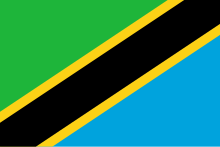 The flag of Tanzania | |
| Data | |
|---|---|
| Water coverage (broad definition) | (improved water source) 52% (2007, household survey),[1] 50% ('at least basic' definition,2017, JMP)[2] |
| Sanitation coverage (broad definition) | (improved sanitation) 33% (2006, household survey),[1] 24% ('at least basic' definition, 2017, JMP)[2] |
| Continuity of supply | Mostly intermittent (17 out of 20 urban areas)[3] |
| Average urban water use (L/person/day) | not available |
| Average urban water and sanitation tariff (US$/m3) | 0.34 (2008)[3] |
| Share of household metering | 60% (in 20 urban areas)[3] |
| Annual investment in WSS | US$175m (fiscal year 2008–09), or US$4/capita[3] |
| Share of self-financing by utilities | Low |
| Share of tax-financing | Low |
| Share of external financing | 88%[3] |
| Institutions | |
| Decentralization to municipalities | Yes |
| National water and sanitation company | No |
| Water and sanitation regulator | Energy and Water Utilities Regulatory Authority (EWURA) |
| Responsibility for policy setting | Ministry of Water and Irrigation (water supply), Ministry of Health and Social Welfare (sanitation) |
| Sector law | Water Supply and Sanitation Act Nr. 12 of 2009 |
| No. of urban service providers | 20 Urban Water and Sanitation Authorities (UWSSAs) in cities, about 100 in towns |
| No. of rural service providers | 8,394 water committees (2007) |
Water supply and sanitation in Tanzania is characterised by: decreasing access to at least basic water sources in the 2000s (especially in urban areas), steady access to some form of sanitation (around 93% since the 1990s), intermittent water supply and generally low quality of service.[3] Many utilities are barely able to cover their operation and maintenance costs through revenues due to low tariffs and poor efficiency. There are significant regional differences and the best performing utilities are Arusha and Tanga.[4]
The Government of Tanzania has embarked on a major sector reform process since 2002 when an update was made to the National Water Policy NAWAPO. At that time, the central government reported that only 42% of rural households had access to improved water and that 30% of all water systems in the country were inoperative.[5] An ambitious National Water Sector Development Strategy that promotes integrated water resources management and the development of urban and rural water supply was adopted in 2006. Decentralisation has meant that responsibility for water and sanitation service provision has shifted to local government authorities and is carried out by 20 urban utilities and about 100 district utilities, as well as by Community Owned Water Supply Organizations in rural areas.[3]
These reforms have been backed by a significant increase of the budget starting in 2006, when the water sector was included among the priority sectors of the National Strategy for Growth and Reduction of Poverty MKUKUTA. The Tanzanian water sector remains heavily dependent on external donors: 88% of the available funds are provided by external donor organisations.[6] Results have been mixed. For example, a report by GIZ notes that "despite heavy investments brought in by the World Bank and the European Union, (the utility serving Dar es Salaam) has remained one of the worst performing water entities in Tanzania."[7]
- ^ a b Cite error: The named reference
NHBSwas invoked but never defined (see the help page). - ^ a b WHO/UNICEF Joint Monitoring Programme for Water Supply and Sanitation. "Data table for the United Republic of Tanzania". Archived from the original on 9 February 2014. Retrieved 19 April 2012.
- ^ a b c d e f g Cite error: The named reference
mowiwas invoked but never defined (see the help page). - ^ Caroline van den Berg, Eileen Burke, Leonard Chacha and Flora Kessy, Public Expenditure Review of the Water Sector Archived 6 October 2011 at the Wayback Machine, September 2009
- ^ Giné, Ricard; Pérez-Foguet, Agustí (November 2008). "Sustainability assessment of national rural water supply program in Tanzania". Natural Resources Forum. 32 (4): 327–342. doi:10.1111/j.1477-8947.2008.00213.x. hdl:2117/8151.
- ^ Cite error: The named reference
NWSDSwas invoked but never defined (see the help page). - ^ GIZ:Water Supply and Sanitation Sector Reforms in Kenya, Tanzania, Uganda and Zambia:Challenges and Lessons[permanent dead link], 2008, pp. 8-9